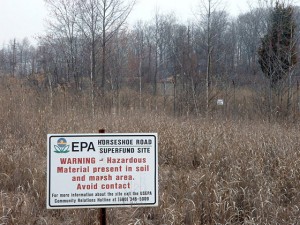Last week I presented a series on Emergency Planning and Community Right to Know Act (EPCRA), in the second part of that series I discussed Emergency Release Notification Requirements. I briefly mentioned the intersection between the Comprehensive Environmental Response Compensation and Liability Act (CERCLA) also known as Superfund. This intersection applies to releases (or spills of hazardous substances into the environment) but there are other aspects of CERCLA that I will discuss here. CERCLA is the regulation which permits the Environmental Protection Agency (EPA) to remediate locations that are abandoned or uncontrolled hazardous waste sites. A number of legalities are involved but the ultimate result is clean up of these hazardous waste sites when responsible parties cannot be assigned or fail to clean these areas–although this effort may take years. The programs includes site identification, monitoring and response activities that are coordinated through state environmental protection and waste management agencies. The areas are identified on the National Priorities List (NPL)–a list of the known releases or threatened releases of hazardous substances, pollutants, or contaminants throughout the United States and its territories. Sites are included on this list through:
(EPCRA), in the second part of that series I discussed Emergency Release Notification Requirements. I briefly mentioned the intersection between the Comprehensive Environmental Response Compensation and Liability Act (CERCLA) also known as Superfund. This intersection applies to releases (or spills of hazardous substances into the environment) but there are other aspects of CERCLA that I will discuss here. CERCLA is the regulation which permits the Environmental Protection Agency (EPA) to remediate locations that are abandoned or uncontrolled hazardous waste sites. A number of legalities are involved but the ultimate result is clean up of these hazardous waste sites when responsible parties cannot be assigned or fail to clean these areas–although this effort may take years. The programs includes site identification, monitoring and response activities that are coordinated through state environmental protection and waste management agencies. The areas are identified on the National Priorities List (NPL)–a list of the known releases or threatened releases of hazardous substances, pollutants, or contaminants throughout the United States and its territories. Sites are included on this list through:
- EPAs Hazard Ranking System (HRS).
- The second mechanism for placing sites on the NPL allows States or Territories to designate one top-priority site regardless of score.
- The third mechanism allows listing a site if it meets all three of these requirements:
-
-
- the Agency for Toxic Substances and Disease Registry (ATSDR) of the U.S. Public Health Service has issued a health advisory that recommends removing people from the site;
- EPA determines the site poses a significant threat to public health; and
- EPA anticipates it will be more cost-effective to use its remedial authority (available only at NPL sites) than to use its emergency removal authority to respond to the site.
-
After a site is listed on the NPL the remedial investigation/feasibility study is used to determine the risk presented to human health & the environment.
Where does the term Superfund come from? The Superfund Amendments and Reauthorization Act of 1986 (SARA) extended the authority of CERCLA and also provided a tax on hazardous materials that allowed for the allocation of monies to fund the clean up of NPL sites. This leads into the discussion on the CERCLA release notification requirements, the purpose of which is to help EPA identify sites that potentially warrant a response action. As mentioned in the post EPCRA Emergency Release Notification Requirements, CERCLA hazardous substance releases that meet or exceed the reportable quantity (within a 24 hour period) must be reported to the National Response Center (NRC). If the hazardous substance is also a Environmentally Hazardous Substance (EHS) as defined by EPCRA (over one third of EHSs are also CERCLA hazardous substances) it must also be reported as discussed in the post ECPRA Emergency Release Notifications.
More questions about CERLCA? Following are some resources that can provide some answers.
EPA’s Superfund Homepage
Superfund Clean Up Policies & Guidance
Contaminated Site Clean Up Information Training Center
Superfund Sites Where You Live
Do you have other resources on CERCLA? If so share them by leaving a comment below.


1 thought on “CERCLA Basics”
Comments are closed.